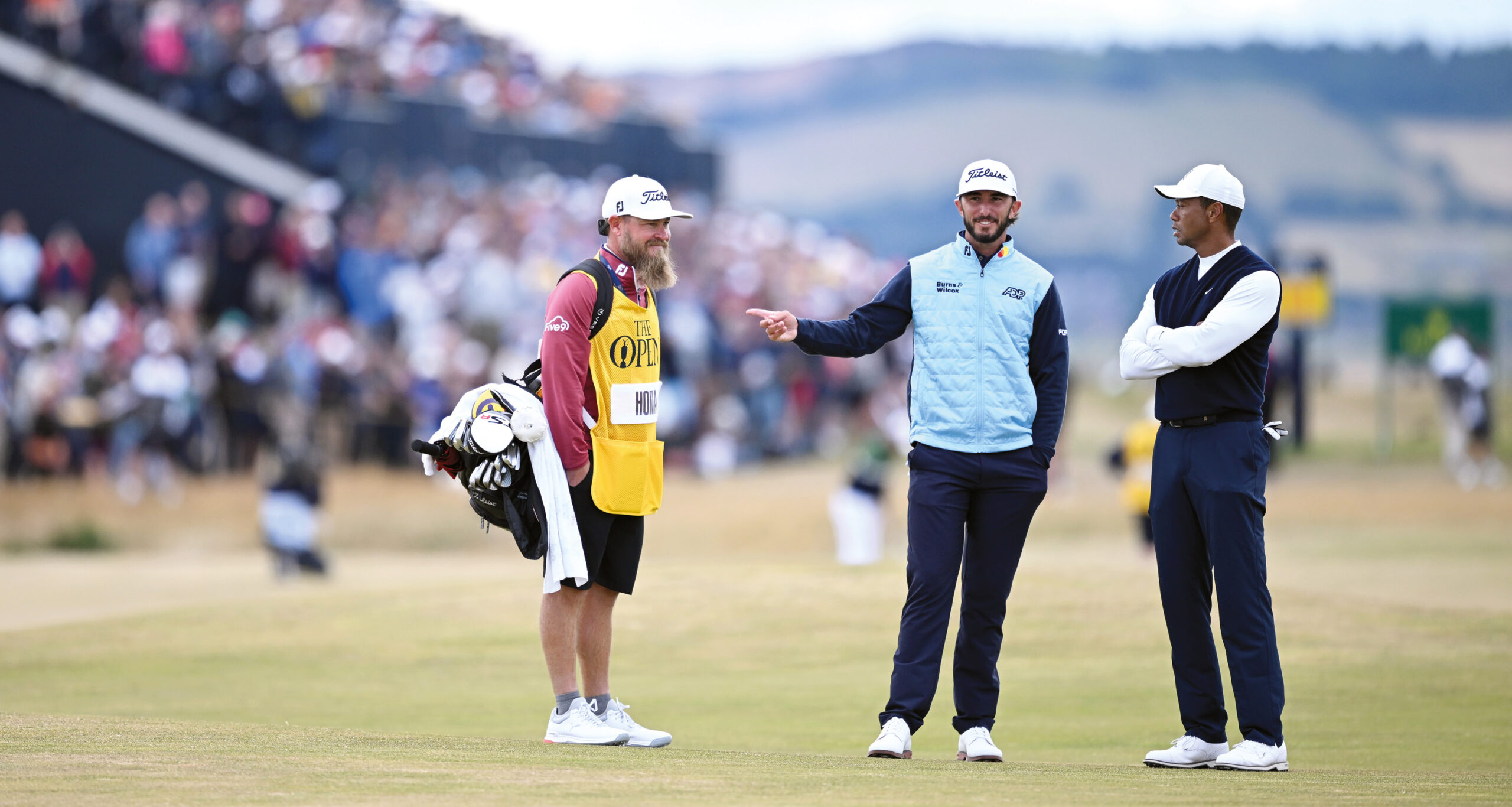
wo years ago, at the 150th Open at St Andrews, a dream came true for Max Homa when he was drawn to play with his childhood hero, Tiger Woods, for the first time. “I was shaking like a leaf on the first hole,” admits Homa, speaking exclusively to Kingdom magazine earlier this year. “It was a weird day, because we had something like a six-hour round. It was the slowest round of my life. Matt Fitzpatrick was also in our group, and he and I get along really well, and Matt said that if we had been playing with anyone else, we would have been complaining all day. But because we were playing with Tiger, it was actually nice to be out there with him for so long.”
For Woods, the 2022 Open became a 36-hole exercise in frustration and pain, as he limped his way around the Old Course for two days before missing the cut. Twice, in The Opens of 2000 and 2005, Woods had been peerless at the “Home of Golf,” and at the close of his second round in 2022, it got emotional. Homa and Fitzpatrick—the latter of whom had been crowned U.S. Open champion weeks before—were close by to witness a massive St Andrews crowd give Woods a standing ovation on the 18th hole. Woods stood on the Swilcan Bridge and raised his cap. His two playing partners stayed a few paces back, as the former champ bowed out of an Open at St Andrews, almost certainly for the last time.
The moment was particularly poignant for Homa, who grew up in Valencia, California. “We used to go to the L.A. Open,” recalls the now 33-year-old golfer, who was six when Woods transformed golf with his first major title at the 1997 Masters. “I had a hat that I would bring every year for autographs. I filled that thing up as best I could—it had no room on it in the end. I tried my damnedest to get Tiger’s autograph for, gosh, so many years, but I never got it. It was a tough autograph to get.”
At St Andrews, Homa belatedly got the signature he most wanted—not on his cap but on his scorecard. More memorable, however, was a conversation the pair had on the ninth fairway. “Tiger came up and asked me how many tour events I had won,” recalls Homa, who had won four times on the PGA Tour at that point, including the 2021 Genesis Invitational (previously known as the L.A. Open, where Homa hunted autographs), where he was presented with the trophy from tournament host Woods.
“I made some little joke about how I only needed another 78 wins to catch him, and very seriously, Tiger said that I should win a lot more tournaments. I kind of giggled, and he said it again, and I have kept that in my head. If the GOAT thinks I am underachieving, then I should probably have a little more confidence in myself.”

As the 2024 majors loom, there is no question that Homa belongs in contention. He now has six PGA Tour wins to his name—only 76 behind Woods now—but for a player of his caliber, his majors record is undercooked, with just one top-10 finish so far. Still, Homa’s coach, Englishman Mark Blackburn, says the former NCAA champion with the University of California, Berkeley, is built for winning majors on tough golf courses due to his mental toughness and calmness.
“I pay Mark a lot of money to say those kinds of things!” jokes Homa, whose witty one-liners have earned him 640,000 followers on X. “I have not really shown it yet, but once I get out of my own way and let myself play golf like I do in regular tour events, I have a well-rounded game that fits most of those hard majors golf courses. I know I am really good at dealing with the pressure on Saturdays and Sundays. Some people struggle when they get into the mix, but I struggle to get into the mix in the first place. I have been thinking about it a lot lately. It’s like, I have a plan of how the week is going to go, and then I get punched in the mouth on the Thursday, and my alarm bells seem to go off a lot too fast.
“I need to do a better job of not panicking about anything, and just play golf as it comes,” he continues. “Look at Jon Rahm last year at the Masters: He won after having a four-putt at the first hole. It’s that kind of thing that I have been terrible at, and what I am hoping to be better at.”
Homa talks in unvarnished truths, and he is self-deprecating, which makes him instantly likable. As a professional athlete, however, his stark honesty can be self-obstructive, too. As Homa says, he needs to get out of his own way.
During his early years as a professional, Homa encountered most of his problems off the tee. His inconsistency resulted in a five-year spell bouncing between missed opportunities on the PGA Tour and rebuilding on the secondary Korn Ferry Tour. In 2017, he missed the cut in 15 out of 17 PGA Tour starts.
“I understand that people have been in lower places, and I don’t mean to demean that, but 2017 was my worst season by a mile,” says Homa, who lost playing status to the extent that he traveled to an Adams Pro Tour event at Brownwood Country Club, 170 miles west of Dallas. “It was the middle of nowhere. I remember sitting in a hotel room by myself, with very little Wi-Fi or phone service. I did a lot of thinking, and I was highly motivated to not be in that position anymore.”
Homa was paired that week with a local club pro, who asked him what he did for a living. “I said that I had played on the PGA Tour that year,” says Homa, who turned pro in 2013 and won on the PGA Tour for the first time in 2019. “That was not the most fun feeling, to be playing in this mini-tour event, halfway across the country from where I lived, because I had lost all of my playing status.”
To make it worse, Homa shot 69-71 and missed the cut by three shots. All that way for two competition rounds and nil dollars in return.
“But that is kind of the fun of this job in a way,” he reflects. “Nobody has a linear career if you look at guys on tour—although Jon Rahm has probably had the closest thing to linear, but even Jon would probably say that he had hit a bunch of speed bumps along the way.
“It is easier to look back on that week in Texas now than it was to be living it at the time,” he continues. “You’ve just got to put one foot in front of the other and get to work, and hopefully something clicks. I am thankful that it did.”
“You’ve just got to put one foot in front of the other and get to work, and hopefully something clicks. I am thankful that it did.” —Max Homa

As it happens, Homa’s history of starting badly dates right back to his first ever competitive golf shot, when he was six, in a father-son scramble on the par-3 course at Vista Valencia.
“They had great junior events on the par-3 course,” starts Homa. “I was pretty nervous, and I was taking a practice swing, and I hit the ball with the toe of the club. The ball went about 20 yards dead right. That was my first ever competitive golf shot. It was very embarrassing. I remember that I felt like crying, but as it was a scramble, my dad got to tee off for us as well.”
The Homa family moved to Valencia, just north of Los Angeles, when he was three years old, and the 27-hole, public Vista Valencia Golf Course, on Trevino Drive, became Homa’s home away from home.
“Vista Valencia is still one of my favorite places to go,” he says. “It is a par-61 golf course with a massive driving range that is lit up at night. Back in the day, they had a fantastic junior rate, so you could play the par-3 course as many times as you like for $1. The club was definitely tailored for kids and inclusivity. If you went there right now, even if it is raining, I bet the range would be pretty darn full. We would just go there and hang out, and there were so many kids that it had a summer camp–type feel, but all the time.”
Also growing up at Vista Valencia was a kid called Joe Greiner, four years older than Homa, and who is now Homa’s caddie.
“I will say this as a fact: Joe Greiner taught me how to gamble,” Homa says with a laugh. “He taught me how to hustle a little bit; some of it was direct and some was from watching him, and this was life at Vista Valencia. Joe and this other kid, Brandon Christianson—who is now the head golf coach at Cal State Stanislaus—were the best two golfers I had ever seen. It was inspiring to be around them, and us younger kids thought they would be the next Tiger Woods. They were incredibly good at golf. I think about it all the time, and it is pretty darn special to have somebody who I grew up with at the same club, and that we are still somehow in the golf world together.”
Taking the “scenic” route to the top explains why he did not get the chance to walk the fairways with Woods until he was 31. It also explains why Woods’s words meant so much to Homa. Maybe he will win a major title, maybe not, but you can’t help hoping that he does.

Follow Us On


| Cookie | Duration | Description |
|---|---|---|
| cookielawinfo-checkbox-analytics | 11 months | This cookie is set by GDPR Cookie Consent plugin. The cookie is used to store the user consent for the cookies in the category "Analytics". |
| cookielawinfo-checkbox-functional | 11 months | The cookie is set by GDPR cookie consent to record the user consent for the cookies in the category "Functional". |
| cookielawinfo-checkbox-necessary | 11 months | This cookie is set by GDPR Cookie Consent plugin. The cookies is used to store the user consent for the cookies in the category "Necessary". |
| cookielawinfo-checkbox-others | 11 months | This cookie is set by GDPR Cookie Consent plugin. The cookie is used to store the user consent for the cookies in the category "Other. |
| cookielawinfo-checkbox-performance | 11 months | This cookie is set by GDPR Cookie Consent plugin. The cookie is used to store the user consent for the cookies in the category "Performance". |
| viewed_cookie_policy | 11 months | The cookie is set by the GDPR Cookie Consent plugin and is used to store whether or not user has consented to the use of cookies. It does not store any personal data. |